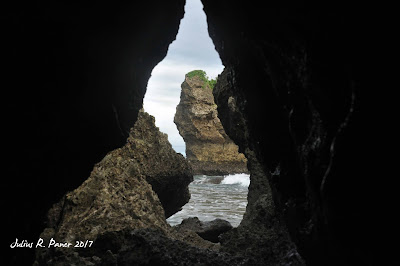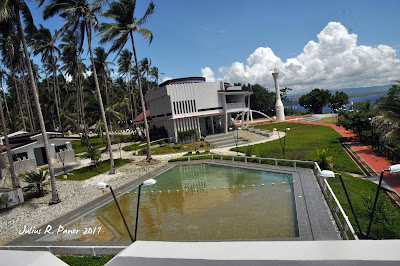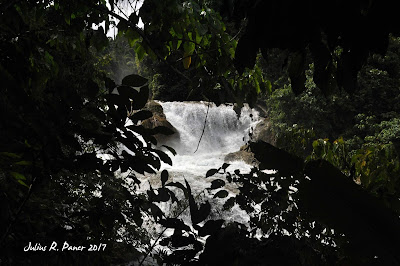Two days after completing the 2017 version of Pista sa Kinaiyahan (PSK)
had me joining a trip in Davao Oriental for an experiential field visit to some
of the province’s protected areas last May 3-5. It was the first time I
completed the Davao Oriental loop and I personally discovered that this
province is as good as advertised in terms of tourism. I also considered the
expedition a breather of sort because I was practically worn out of the PSK
and, as expected, the trip somehow gave me a respite and mental recovery.
The first day saw us visiting the Mt. Hamiguitan Natural Science
Museum located in Barangay La Union, Municipality of San Isidro. The museum was
erected after Mt. Hamiguitan was inscribed into the list of UNESCO World
Heritage sites in 2014, basically to provide guests with comprehensive details
of Mt. Hamiguitan without climbing it. Inside the museum is a walk through the
rich biodiversity of Mt. Hamigutian, ranging from its unique flora and
indigenous fauna species.
Although I already climbed this mountain twice there are still other
things I learned only in the museum. I also appreciate the conservation
mechanism of the provincial government in order to maintain the mountain’s
natural state. While staying in San Isidro’s government-owned accommodation
center called Huyu-anan, I learned that sustaining a UNESCO World Heritage site
is very challenging as conversed by no less than the town Mayor Madam Tina Yu. Upon
listening to her I instantly realized that the mayor is serious in her quest to
save Mt. Hamiguitan from destruction. In her early tenure as Local Chief
Executive of San Isidro there were already persuasions for her to open up
chromite mining within the Hamiguitan
Range and Wildlife Sanctuary but the good lady mayor refused the offer. She set
aside immediate economic benefits of mining in exchange of environmental
protection. Mayor Yu always believed that there is no amount of economic gains
that could replace the damaged environment.
However, the mayor strongly supports ecotourism as a tool not only to
propel livelihood in the area but also to further safeguard the mountain. In
fact, she revealed that by June this year Mt. Hamiguitan summit will be
reopened for mountain climbers in close coordination with the Protected Area
Management Board of Davao Oriental comprising 3 LGUs in Mati City, Governor Generoso
and San Isidro. Mayor Yu’s pronouncement reaffirms the thought of this blogger
that indeed, ecotourism is not a problem to any mountains in the country but
mining, illegal logging, kaingin and the likes.
After a fruitful stay in Mt. Hamiguitan museum our team travelled
southeast to visit the historic destination of Governor Generoso particularly
in Cape San Agustin which is identified as the tip of southeastern Philippines.
I was amazed by the geography of Cape San Agustin, which junctioned three major
gulfs, Davao Gulf in the right side, Celebes Sea in the center and Pacific
Ocean in the left side. A towering lighthouse was installed to provide sight
guidance to ships which eventually formed part of the tourist attractions in
the area. In a cave structure just below the lighthouse is the very sight where
San Agustin officiated a mass in the pre-Spanish time. To some who love to
trace a certain place’s history, Cape San Agustin is a must-visit destination.
On the second day we stayed in Mati City to visit Dahican Beach and
other significant places in Davao Oriental. We were greeted by the famous
sleeping dinosaur island strategically laid out in the pacific ocean. We also
visited the Subangan Museum in Mati where all features of Davao Oriental is
being fused together and showcased. To be honest, this is the only province I
know of having invested so much on museums.
In the evening of May 3 we camped overnight in Menzi Beach Park, an
LGU-operated beach front which is perhaps one of the most-visited resorts in
Mati. The white sand beach and crystal clear water is being intermingled with
the warm people residing in Dahican. The resort also housed several surfing and
skim boarding enthusiasts and a dwelling
place of the very popular surfer Bayogyog.
The town of Cateel was our last destination on the third day. We had
to see for ourselves the alluring Aliwagwag Falls situated within the Aliwagwag
Protected Landscape. But before heading directly to Cateel we had to pass
through the town of Caraga where we dropped by Pusan Point, a legendary spot
where the first sunset sprouts every single day. Pusan Point became famous in
year 2000 when a lot of people flocked there to witness the first sunrise of
the new millennium. The same date was
the establishment of the Jubilee Cross as official millennium landmark.
Again, the provincial government put up another museum in Pusan Point.
Because it is located in the municipality of Caraga, history is the main
subject of the place. Caraga is the oldest town not only in Davao Oriental but
also in the entire Mindanao Island and the historical significance of the town
is being exhibited in Pusan Point.
Adjacent to Caraga is the town of Baganga which is known for its
Sunrise Boulevard located just along the national highway. There we saw the
remnants of Typhoon Pablo through the mangrove barks in almost the entire beach
lines of Baganga. The mangroves slowly started regenerating though and few
years from now Baganga beaches will once again be a greener scenery.
Meanwhile, the Aliwagwag Falls in Cateel is spectacular. This
multi-tiered water body showed its splendour to us featuring cascading
waterfalls in different sizes and currents that eventually formed into a mighty
river downstream. This is one of the country’s most valuable natural heritages.
Personally I am less appreciative of waterfalls but Aliwagwag Falls for me is
incredible. The way it was laid out opposite the lush forest of Cateel is
breathtaking. This is proudly Mindanao and I pray this would be preserve
through eternity.
We completed the Eastern Mindanao loop trip by taking the Cateel to
Compostela Valley route on our way to Davao. This is a much shorter way and
could be a good option instead of taking back the Mati City highway.



































Love to read like of informative stuff always during the United states East Coast tours.
ReplyDelete